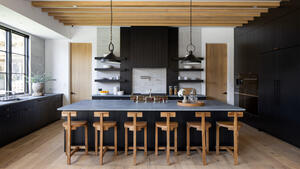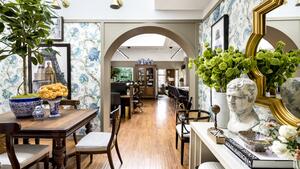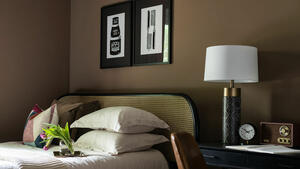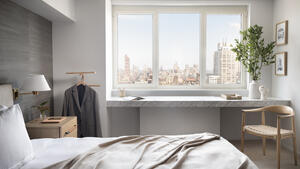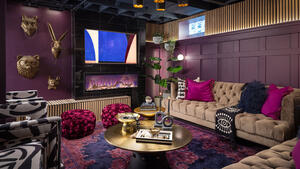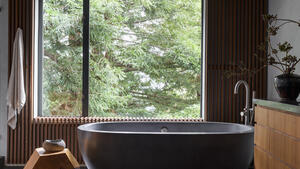Wellness has become a leading idea in the design space, and last week, the virtual edition of the 2021 LivAble Environment Conference leaped headlong into the topic. Across three days of guest speakers and live presentations, the event was rife with discussion on the leading edge of wellness design across residential and commercial industries alike.
At the heart of the conference were the principles of neuroaesthetics—an emerging scientific field that studies the intersection of cognitive behavior and aesthetics. Neurobiologists in the discipline explore how art, music and design impact physical, mental and emotional well-being, in search of explanations to questions that just a few decades ago seemed unanswerable: What makes someone feel moved? Why do compositions trigger the emotional responses that they do?
At the LivAble Conference, neuroaesthetics came into play in nearly every panel—spotlighting data that can serve as a welcome tool for designers whose clients question the value of their services. The programming also featured specific residential design principles and strategies that can support wellness and health in the home.
Below, Business of Home recaps the top takeaways from each day of the conference.
Untapped potential
Architects and designers have fallen behind other industries in their adoption of neuroscience
The first day of the conference offered an exclusive preview of Built Beautiful: An Architecture & Neuroscience Love Story, a documentary produced by the Robert and Judi Newman Family Foundation and architect and author Don Ruggles. The film, which is narrated by Martha Stewart, explores the ways in which built spaces impact the mood and overall well-being of their residents. It takes a systematic, empirical approach to the subject of neuroaesthetics, tapping scientists from more than a dozen U.S. university research centers and several international experts to explore the emerging frontiers of neurobiology as applied to design.
The documentary is predicated on centuries of human art and architectural history and recent neuroscience research that culminate in a single thesis: Wellness is influenced by aesthetics and beauty. “[From] determining which color pops on a billboard to which buzzwords trigger a response from future voters, potential to integrate neuroscience into the arts has been studied for over a decade,” says Stewart. Whether there is a universal definition of beauty is still hotly debated, and despite a definitive neuroscientific conclusion, politicians, retail experts and advertising agencies have been quick to leverage a common visual and auditory rulebook into their work. And while marketing has benefited from these applications of beauty, the architecture and design space is lagging behind, argues Ruggles. The feature-length film will make its official debut at film festivals this summer.
Home away from home
How commercial design strategies can promote wellness in the home space
On day two of the conference, Susan Drew, market segment manager of Senior Living and Behavioral Mental Health at Altro Americas, and Matt Finn, architect and founder of Cognitive Design, discussed the benefits and challenges of integrating commercial design principles in residential architecture. From ADA-certified spaces to the importance of natural exposure in the home, both are looking to answer the question: What are the healthy behavioral outcomes of commercial spaces, and how can we apply that to residential design?
Guided by three key notions—energy, support and comfort—Drew and Finn outlined the design principles that would best translate into residential spaces. Above all, they argue that ergonomic elegance and biomimicry, when specified to individual homeowners, can promote recovery in a home environment. Incorporating plants and water fixtures stand out as clear rejuvenating design elements, while subtler motifs in nature-inspired patterns can also wield restorative power in the home space, and a reduction of visual clutter (particularly in commercial spaces) is a low-cost solution to promoting wellness.
On the horizon
Emerging research in the field of neuroaesthetics could unlock new wellness benefits for your clients and their homes
On the third and final day of the conference, Susan Magsamen and Suchi Reddy explored the broad topic of neuroaesthetics, taking the opportunity to clearly define the discipline. The two had previously worked together to design Google’s installation at the 2018 Milan Design Week, which created three spaces with similar functions but entirely different feelings. In the words of Magsamen: “Aesthetics and good design are fundamental to health in the home.” She emphasized the importance of language in design, as well as a mastery of the sensory stimuli in any given space. In her experience, the old trope that beauty is in the eye of the beholder holds true, and design must be individualized both physiologically and psychologically to optimize any given space through lighting, textures and furnishings.
Reddy went on to discuss how design can address socioeconomic differences, explaining that good design doesn’t necessarily need to cost more. In her eyes, thoughtful placement of light fixtures is one powerful way to promote wellness in any budget. “There is not much equity in design,” says Reddy. “But neuroscience could make it more equitable. Aesthetics are in our DNA.”
Homepage image: © Olezzo/Adobe Stock


















